-
 McCarthy Album 05, Photograph 119
McCarthy Album 05, Photograph 119 No caption, c. 1920. Scene along the Sacramento River, showing some houses on the bank and two small rowboats.
-
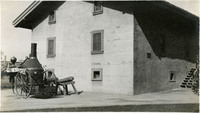 McCarthy Album 05, Photograph 118
McCarthy Album 05, Photograph 118 Caption: "Sutter [sic] Fort. Sacramento.," c. 1920. Image of the main building of Sutter's Fort. John Sutter established the fort in 1839, calling it New Helvetia. After the discovery of gold at one of Sutter's mills (at Coloma, on the American River), almost all of the fort's inhabitants left for the gold fields in the foothills. The fort deteriorated until being restored from 1891-1893. The fort is now the site of a State Historic Park. See also 96-07-08-alb05-117.
-
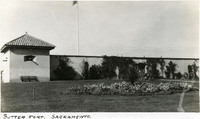 McCarthy Album 05, Photograph 117
McCarthy Album 05, Photograph 117 Caption: "Sutter [sic] Fort. Sacramento.," c. 1920. A gun tower at Sutter's Fort, and a gate bracketed by two cannons. John Sutter established the fort in 1839, calling it New Helvetia. After the discovery of gold at one of Sutter's mills (at Coloma, on the American River), almost all of the fort's inhabitants left for the gold fields in the foothills. The fort deteriorated until being restored from 1891-1893. The fort is now the site of a State Historic Park. See also 96-07-08-alb05-118.
-
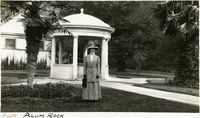 McCarthy Album 05, Photograph 116
McCarthy Album 05, Photograph 116 Caption: "Alum Rock," c. 1910. Grace McCarthy standing in front of a gazebo in Alum Rock Park. The park, founded in 1872, is one of California's oldest municipal parks. The gazebo, the park's oldest standing structure (built in about 1890), features a fountain that used to supply water from the mineral springs in the area. Today, the fountain's water comes from the City of San Jose's municipal supply.
-
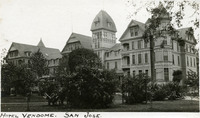 McCarthy Album 05, Photograph 115
McCarthy Album 05, Photograph 115 Caption: "Hotel Vendome. San Jose.," c. 1910. View of the Hotel Vendome, a resort hotel built in San Jose in 1889. The hotel was demolished in 1930, the land subdivided and sold as residential lots.
-
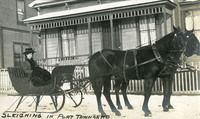 McCarthy Album 05, Photograph 114
McCarthy Album 05, Photograph 114 Caption: "Sleighing in Port Townsend," c. 1910. Grace McCarthy sitting in horse-drawn sleigh in front of a snow-covered residence in Port Townsend, Washington. See also 96-07-08-alb08-049.
-
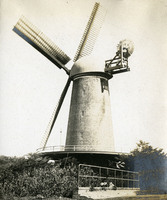 McCarthy Album 05, Photograph 113
McCarthy Album 05, Photograph 113 No caption, c. 1910. Image of the Dutch Windmill in Golden Gate Park, built in 1903 to pump ground water within the park for irrigation purposes.
-
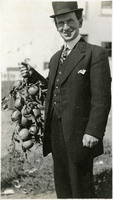 McCarthy Album 05, Photograph 112
McCarthy Album 05, Photograph 112 No caption, c. 1910. William McCarthy holding a branch from an apple tree, with several apples still attached.
-
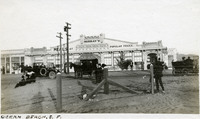 McCarthy Album 05, Photograph 111
McCarthy Album 05, Photograph 111 Caption: "Ocean Beach, S.F.," c. 1910. Scene at Ocean Beach, San Francisco, with eating establishment Murray's in the background. The photograph features both motor car and horse-and-buggy transportation methods.
-
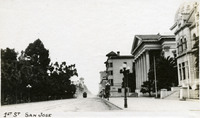 McCarthy Album 05, Photograph 110
McCarthy Album 05, Photograph 110 Caption: "1st St San Jose," c. 1910. Street scene showing stately buildings on the right side of the photograph, while trees line the street on the left. A trolley car can be seen in the distance.
-
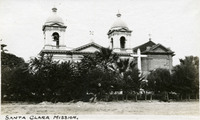 McCarthy Album 05, Photograph 109
McCarthy Album 05, Photograph 109 Caption: "Santa Clara Mission," c. 1910. Founded in 1777, Mission Santa Clara featured several different churches over the years. This photograph shows the mission church as it appeared from roughly 1861 to 1926. In the 1860s, Santa Clara College President Burchard Villager decided to rebuild many of the buildings on the campus. In the process, the mission church was renovated in the Italianate style, with a second bell tower. This Italianate-style church burned in 1926. The church was then rebuilt as a modern reconstruction of the fifth church on the site, the original of which was destroyed by fire in 1825.
-
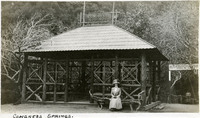 McCarthy Album 05, Photograph 108
McCarthy Album 05, Photograph 108 Caption: "Congress Springs.," c. 1910. Grace McCarthy seated on an unusual bench made from a tree branch and logs, in front of a timber shelter at Pacific Congress Springs near Saratoga in California's Santa Clara Valley. Pacific Congress Springs, a mineral spring named after Congress Springs in New York, operated as a resort area from the nineteenth century until the 1930s.
-
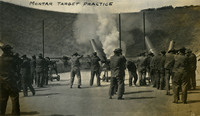 McCarthy Album 05, Photograph 107
McCarthy Album 05, Photograph 107 Caption: "Mortar Target Practice," c. 1910. Large-caliber mortars with associated gun crews at target practice. At least one gun has just been, or is about to be, fired, given that the men are all holding their hands against their ears. See also 96-07-08-alb05-105 and 107.
-
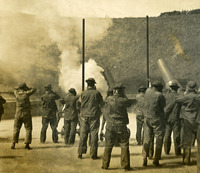 McCarthy Album 05, Photograph 106
McCarthy Album 05, Photograph 106 No caption, c. 1910. Large-caliber mortars with associated gun crews at target practice. At least one gun has just been, or is about to be, fired, given that the men are all holding their hands against their ears. See also 96-07-08-alb05-105 and 107.
-
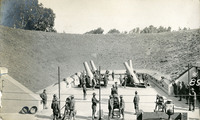 McCarthy Album 05, Photograph 105
McCarthy Album 05, Photograph 105 No caption, c. 1910. Four large-caliber mortars with associated gun crews at target practice. See also 96-07-08-alb05-106 and 107.
-
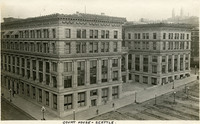 McCarthy Album 05, Photograph 104
McCarthy Album 05, Photograph 104 Caption: "Court House -- Seattle.," c. 1916. The King County Courthouse in downtown Seattle, Washington, was built in 1916 as a five-story structure, as shown in this photograph. Six floors were added in 1930, and another three before 1965. In 1967, a massive remodeling project imposed aluminum curtain walls on the building's east and west sides, changed the main entryway switched to Third Avenue rather than Jefferson Street, and made other changes to the interior.
-
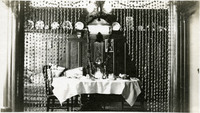 McCarthy Album 05, Photograph 103
McCarthy Album 05, Photograph 103 No caption, c. 1910. Image of parlor or dining room decorated for a celebration. Strings of beads or bells hang around the entry to the room.
-
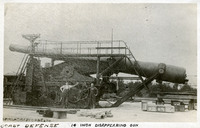 McCarthy Album 05, Photograph 102
McCarthy Album 05, Photograph 102 Caption: "Coast Defense: 14 Inch Disappearing Gun." Another copy of a C.D. Heath photograph, this image shows a heavy artillery gun, with two unidentified men standing next to it, at the Sandy Hook Proving Ground. Located at Sandy Hook, New Jersey, the Sandy Hook Proving Ground was used by the U.S. Army to test ordinance and materiel from 1874-1919. See also 96-07-08-alb05-101.
-
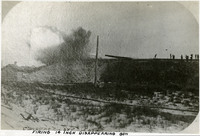 McCarthy Album 05, Photograph 101
McCarthy Album 05, Photograph 101 Caption: "Firing 14 Inch Disappearing Gun." This is a copy of a photograph taken by C.D. Heath at the Sandy Hook Proving Ground. It shows a heavy artillery gun firing from an embankment upon which several people stand. Located at Sandy Hook, New Jersey, the Sandy Hook Proving Ground was used by the U.S. Army to test ordinance and materiel from 1874-1919. See also 96-07-08-alb05-102.
-
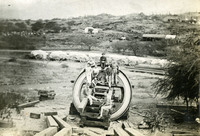 McCarthy Album 05, Photograph 100
McCarthy Album 05, Photograph 100 No caption, c. 1909-1915. Group of unidentified men gathered around a part of what appears to be a 12-inch mortar at Fort Ruger, Hawaii. Farm buildings and rolling hills appear in the distance. Fort Ruger was established on the Island of O'ahu by the U.S. in 1906 as the Diamond Head Reservation. Its name was changed to Fort Ruger in 1909. See also 96-07-08-alb05-098 and 099.
-
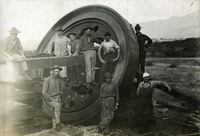 McCarthy Album 05, Photograph 099
McCarthy Album 05, Photograph 099 No caption, c. 1909-1915. Group of unidentified men gathered around a part of what appears to be a 12-inch mortar at Fort Ruger, Hawaii. Fort Ruger was established on the Island of O'ahu by the U.S. in 1906 as the Diamond Head Reservation. Its name was changed to Fort Ruger in 1909. See also 96-07-08-alb05-098 and 100.
-
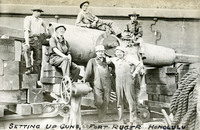 McCarthy Album 05, Photograph 098
McCarthy Album 05, Photograph 098 Caption: "Setting Up Guns, Fort Ruger Honolulu," c. 1909-1915. Group of unidentified men gathered around unassembled pieces of what appears to be a 12-inch mortar at Fort Ruger, Island of O'ahu, Hawaii. Fort Ruger was established by the U.S. in 1906 as the Diamond Head Reservation. Its name was changed to Fort Ruger in 1909. See also 96-07-08-alb05-099 and 100.
-
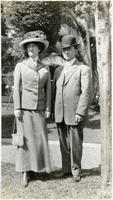 McCarthy Album 05, Photograph 097
McCarthy Album 05, Photograph 097 No caption, c. 1915. William and Grace McCarthy posing together in a garden. See also 96-07-08-alb04-250, and 96-07-08-alb05-090, 091, 092, and 096.
-
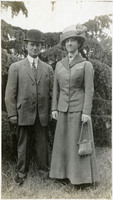 McCarthy Album 05, Photograph 096
McCarthy Album 05, Photograph 096 No caption, c. 1915. William and Grace McCarthy posing together in a garden. See also 96-07-08-alb04-0, 250 and 96-07-08-alb05-090, 091, 092, and 097.
-
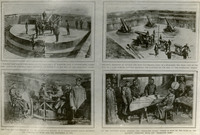 McCarthy Album 05, Photograph 095
McCarthy Album 05, Photograph 095 No caption. Photograph of part of a print from the Illustrated London News, regarding placement and operation of coastal artillery defense methods. See also 96-07-08-alb08-231.
-
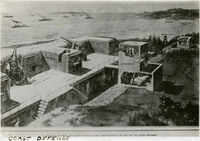 McCarthy Album 05, Photograph 094
McCarthy Album 05, Photograph 094 Caption: "Coast Defense." Photograph of part of a print from the Illustrated London News, titled "A Modern Method of Coast Defense: The Arrangement of an Up-To-Date Battery." See also 96-07-08-alb08-230.
-
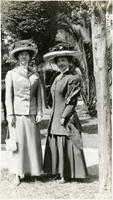 McCarthy Album 05, Photograph 093
McCarthy Album 05, Photograph 093 No caption, c. 1915. Grace McCarthy and an unidentified woman posing in garden.
-
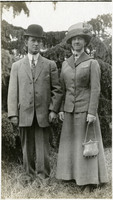 McCarthy Album 05, Photograph 092
McCarthy Album 05, Photograph 092 No caption, c. 1915. William and Grace McCarthy posing together in a garden. See also 96-07-08-alb04-250, and 96-07-08-alb05-090, 091, 096, and 097.
-
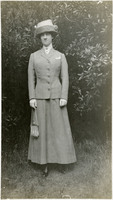 McCarthy Album 05, Photograph 091
McCarthy Album 05, Photograph 091 No caption, c. 1915. Grace McCarthy posing in garden with beaded purse. See also 96-07-08-alb05-092, 093, 096, and 097.
-
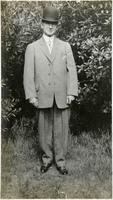 McCarthy Album 05, Photograph 090
McCarthy Album 05, Photograph 090 No caption, c. 1915. William McCarthy posing in garden. See also 96-07-08-alb04-250, and 96-07-08-alb05-092, 096, and 097.
-
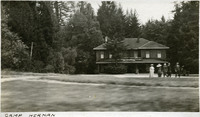 McCarthy Album 05, Photograph 089
McCarthy Album 05, Photograph 089 Caption: "Camp Herman," c. 1912-1915. View of the Zayante Inn at Mount Herman. Originally the site of Hotel Tuxedo, in 1906 a group later known as the Mount Herman Association, Inc. purchased the building and surrounding property, and renamed it the Zayante Inn. The inn became a Christian retreat center. Although this building was destroyed by fire in 1921, the retreat center was rebuilt as the Mount Herman Christian Conference Center, still operating today.
-
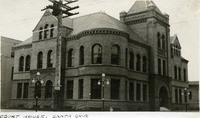 McCarthy Album 05, Photograph 088
McCarthy Album 05, Photograph 088 Caption: "Court House, Santa Cruz," c. 1912-1915. Image of the courthouse building constructed in Santa Cruz in 1896. The building was periodically renovated, the most extensive occurring after the 1906 earthquake, when much of the courthouse had to be rebuilt. In 1967, the county removed its court facilities to a new building. The old courthouse was subsequently remodeled, opening in 1972 as an office and retail building. Heavy damages sustained in 1989 as a result of the Loma Prieta earthquake necessitated the building's demolition. Please note that this photograph appears to be reversed, as this is a mirror image of the structure.
-
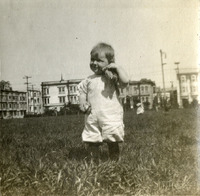 McCarthy Album 05, Photograph 087
McCarthy Album 05, Photograph 087 No caption, c. 1912-1915. Unidentified toddler standing in field holding teddy bear and ball, with buildings in distance. See also 96-07-08-alb05-083, 085, and 086.
-
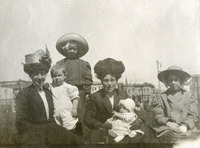 McCarthy Album 05, Photograph 086
McCarthy Album 05, Photograph 086 No caption, c. 1912-1915. Two unidentified women with four children, one of which (standing next to women at far left) is the same toddler who appears in 96-07-08-alb05-083 and 084.
-
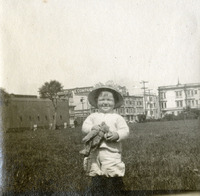 McCarthy Album 05, Photograph 085
McCarthy Album 05, Photograph 085 No caption, c. 1912-1915. Unidentified toddler standing in field with buildings in distance, holding a teddy bear and ball. See also 96-07-08-alb05-083.
-
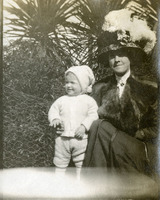 McCarthy Album 05, Photograph 084
McCarthy Album 05, Photograph 084 No caption, c. 1912-1915. Grace McCarthy kneeling with unidentified toddler in garden. See also 96-07-08-alb05-082.
-
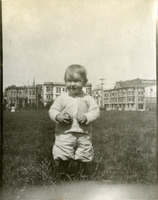 McCarthy Album 05, Photograph 083
McCarthy Album 05, Photograph 083 No caption, c. 1912-1915. Unidentified toddler standing in field with buildings in distance. See also 96-07-08-alb05-085.
-
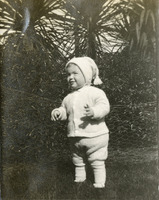 McCarthy Album 05, Photograph 082
McCarthy Album 05, Photograph 082 No caption, c. 1912-1915. Unidentified toddler standing in yard or garden. See also 96-07-08-alb05-084.
-
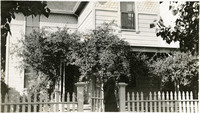 McCarthy Album 05, Photograph 081
McCarthy Album 05, Photograph 081 No caption, c. 1912-1915. Unidentified woman standing at the gate to a white picket fence in front of a residence.
-
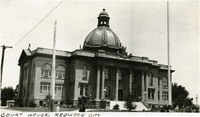 McCarthy Album 05, Photograph 080
McCarthy Album 05, Photograph 080 Caption: "Court House, Redwood City," c. 1912-1915. View of the Redwood City Courthouse building, constructed in 1910 and designed by Glenn Allen. This was the fourth courthouse built on the site. The dome was originally part of the third courthouse building, and was the only portion of that structure to survive the 1906 earthquake. It was subsequently incorporated into the fourth courthouse building, dubbed the Temple of Justice. In 1939 the county removed the courthouse's facade in order to add a new building (the Fiscal Building) to the site. The Fiscal Building was torn down in 2005 and the original facade of the fourth courthouse reconstructed.
-
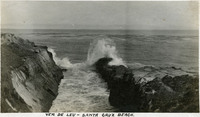 McCarthy Album 05, Photograph 079
McCarthy Album 05, Photograph 079 Caption: "Ver De Leu [sic], Santa Cruz Beach.," c. 1910. Ocean shore scene with rocks, waves, and high spray. The Vue de L'eau (View of the Water) was a station on the Santa Cruz, Garfield Park and Capitola Electric Railway electric streetcar line. The station, built in 1891, was located at the very end of the line, on a promontory overlooking the Pacific Ocean. It featured an observatory on the top story. The same company also built a casino, ballroom, and restaurant nearby. The station burned down in 1925.
-
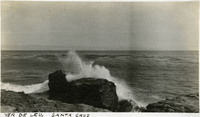 McCarthy Album 05, Photograph 078
McCarthy Album 05, Photograph 078 Caption: "Ver De Leu [sic], Santa Cruz," c. 1910. Ocean shore scene with rocks, waves, and high spray. The Vue de L'eau (View of the Water) was a station on the Santa Cruz, Garfield Park and Capitola Electric Railway electric streetcar line. The station, built in 1891, was located at the very end of the line, on a promontory overlooking the Pacific Ocean. It featured an observatory on the top story. The same company also built a casino, ballroom, and restaurant nearby. The station burned down in 1925.
-
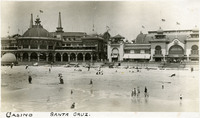 McCarthy Album 05, Photograph 077
McCarthy Album 05, Photograph 077 Caption: "Casino Santa Cruz.," c. 1910. View of beach and casino building in Santa Cruz. The casino, designed by William Weeks, was constructed in 1907, replacing a previous casino building that burned down in 1906.
-
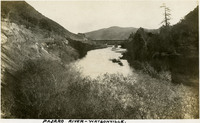 McCarthy Album 05, Photograph 076
McCarthy Album 05, Photograph 076 Caption: "Pajaro River -- Watsonville," c. 1912-1915. River scene on the Pajaro River near Watsonville, with a bridge in the distance.
-
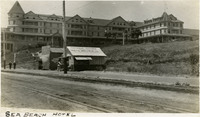 McCarthy Album 05, Photograph 075
McCarthy Album 05, Photograph 075 Caption: "Sea Beach Hotel," c. 1910. The Sea Beach Hotel, located on Beach Hill in Santa Cruz, was built in the 1870s by S.A. Hall. Originally called the Ocean View House, it was sold in the 1880s. Its new owner dubbed the building the Sea Beach Hotel. The resort hotel operated until burning down in 1912, never to be reconstructed.
-
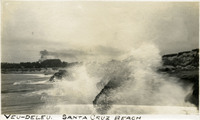 McCarthy Album 05, Photograph 074
McCarthy Album 05, Photograph 074 Caption: "Veu-Deleu [sic] Santa Cruz Beach," c. 1910. Ocean shore scene with waves and high spray. The Vue de L'eau (View of the Water) was a station on the Santa Cruz, Garfield Park and Capitola Electric Railway electric streetcar line. The station, built in 1891, was located at the very end of the line, on a promontory overlooking the Pacific Ocean. It featured an observatory on the top story. The same company also built a casino, ballroom, and restaurant nearby. The station burned down in 1925. See also 96-07-08-alb08-192.
-
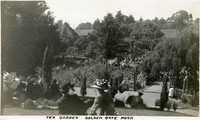 McCarthy Album 05, Photograph 073
McCarthy Album 05, Photograph 073 Caption: "Tea Garden Golden Gate Park," c. 1912-1915. View of the five-acre Japanese Tea Garden in San Francisco's Golden Gate Park. Established in 1894 by George Turner Marsh for the Midwinter Exposition of that year, it is the oldest public Japanese Tea Garden in the U.S.
-
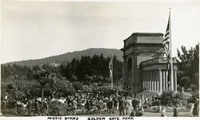 McCarthy Album 05, Photograph 072
McCarthy Album 05, Photograph 072 Caption: "Music Stand Golden Gate Park," c. 1912-1915. View of the Spreckels Temple of Music, commonly known as the Music Stand or the Bandshell. The Temple was built in 1899-1900 at the west end of the Music Concourse in Golden Gate Park. A gift to the City of San Francisco from sugar magnate Claus Spreckels, the Temple has been extensively renovated over the years to repair earthquake damage.
-
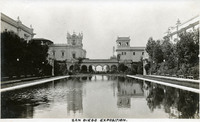 McCarthy Album 05, Photograph 071
McCarthy Album 05, Photograph 071 Caption: "San Diego Exposition," c. 1915-1916. View of an artificial lagoon, with the Commerce and Industries Building (tower at left, now called Casa de Balboa) and the Foreign Arts Building (tower at right, now called the House of Hospitality). The Panama-California Exposition was held in San Diego in 1915 and 1916 to celebrate the opening of the Panama Canal. It was smaller in scale and less well-funded than the Panama-Pacific International Exposition held in 1915 in San Francisco. See also 96-07-08-alb04-111, and 112.
-
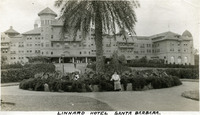 McCarthy Album 05, Photograph 070
McCarthy Album 05, Photograph 070 Caption: "Linnard Hotel Santa Barbara.," c. 1920. Grace McCarthy sitting in front of the Hotel Potter. Opened in 1903 by Milo M. Potter, the hotel sold in 1919 to the Santa Barbara Hotel Company, controlled by D.M. Linnard. The famous luxury resort burned down in 1921. See also 96-07-08-alb04-097.
 McCarthy Album 05, Photograph 119 No caption, c. 1920. Scene along the Sacramento River, showing some houses on the bank and two small rowboats.
McCarthy Album 05, Photograph 119 No caption, c. 1920. Scene along the Sacramento River, showing some houses on the bank and two small rowboats. McCarthy Album 05, Photograph 118 Caption: "Sutter [sic] Fort. Sacramento.," c. 1920. Image of the main building of Sutter's Fort. John Sutter established the fort in 1839, calling it New Helvetia. After the discovery of gold at one of Sutter's mills (at Coloma, on the American River), almost all of the fort's inhabitants left for the gold fields in the foothills. The fort deteriorated until being restored from 1891-1893. The fort is now the site of a State Historic Park. See also 96-07-08-alb05-117.
McCarthy Album 05, Photograph 118 Caption: "Sutter [sic] Fort. Sacramento.," c. 1920. Image of the main building of Sutter's Fort. John Sutter established the fort in 1839, calling it New Helvetia. After the discovery of gold at one of Sutter's mills (at Coloma, on the American River), almost all of the fort's inhabitants left for the gold fields in the foothills. The fort deteriorated until being restored from 1891-1893. The fort is now the site of a State Historic Park. See also 96-07-08-alb05-117. McCarthy Album 05, Photograph 117 Caption: "Sutter [sic] Fort. Sacramento.," c. 1920. A gun tower at Sutter's Fort, and a gate bracketed by two cannons. John Sutter established the fort in 1839, calling it New Helvetia. After the discovery of gold at one of Sutter's mills (at Coloma, on the American River), almost all of the fort's inhabitants left for the gold fields in the foothills. The fort deteriorated until being restored from 1891-1893. The fort is now the site of a State Historic Park. See also 96-07-08-alb05-118.
McCarthy Album 05, Photograph 117 Caption: "Sutter [sic] Fort. Sacramento.," c. 1920. A gun tower at Sutter's Fort, and a gate bracketed by two cannons. John Sutter established the fort in 1839, calling it New Helvetia. After the discovery of gold at one of Sutter's mills (at Coloma, on the American River), almost all of the fort's inhabitants left for the gold fields in the foothills. The fort deteriorated until being restored from 1891-1893. The fort is now the site of a State Historic Park. See also 96-07-08-alb05-118. McCarthy Album 05, Photograph 116 Caption: "Alum Rock," c. 1910. Grace McCarthy standing in front of a gazebo in Alum Rock Park. The park, founded in 1872, is one of California's oldest municipal parks. The gazebo, the park's oldest standing structure (built in about 1890), features a fountain that used to supply water from the mineral springs in the area. Today, the fountain's water comes from the City of San Jose's municipal supply.
McCarthy Album 05, Photograph 116 Caption: "Alum Rock," c. 1910. Grace McCarthy standing in front of a gazebo in Alum Rock Park. The park, founded in 1872, is one of California's oldest municipal parks. The gazebo, the park's oldest standing structure (built in about 1890), features a fountain that used to supply water from the mineral springs in the area. Today, the fountain's water comes from the City of San Jose's municipal supply. McCarthy Album 05, Photograph 115 Caption: "Hotel Vendome. San Jose.," c. 1910. View of the Hotel Vendome, a resort hotel built in San Jose in 1889. The hotel was demolished in 1930, the land subdivided and sold as residential lots.
McCarthy Album 05, Photograph 115 Caption: "Hotel Vendome. San Jose.," c. 1910. View of the Hotel Vendome, a resort hotel built in San Jose in 1889. The hotel was demolished in 1930, the land subdivided and sold as residential lots. McCarthy Album 05, Photograph 114 Caption: "Sleighing in Port Townsend," c. 1910. Grace McCarthy sitting in horse-drawn sleigh in front of a snow-covered residence in Port Townsend, Washington. See also 96-07-08-alb08-049.
McCarthy Album 05, Photograph 114 Caption: "Sleighing in Port Townsend," c. 1910. Grace McCarthy sitting in horse-drawn sleigh in front of a snow-covered residence in Port Townsend, Washington. See also 96-07-08-alb08-049. McCarthy Album 05, Photograph 113 No caption, c. 1910. Image of the Dutch Windmill in Golden Gate Park, built in 1903 to pump ground water within the park for irrigation purposes.
McCarthy Album 05, Photograph 113 No caption, c. 1910. Image of the Dutch Windmill in Golden Gate Park, built in 1903 to pump ground water within the park for irrigation purposes. McCarthy Album 05, Photograph 112 No caption, c. 1910. William McCarthy holding a branch from an apple tree, with several apples still attached.
McCarthy Album 05, Photograph 112 No caption, c. 1910. William McCarthy holding a branch from an apple tree, with several apples still attached. McCarthy Album 05, Photograph 111 Caption: "Ocean Beach, S.F.," c. 1910. Scene at Ocean Beach, San Francisco, with eating establishment Murray's in the background. The photograph features both motor car and horse-and-buggy transportation methods.
McCarthy Album 05, Photograph 111 Caption: "Ocean Beach, S.F.," c. 1910. Scene at Ocean Beach, San Francisco, with eating establishment Murray's in the background. The photograph features both motor car and horse-and-buggy transportation methods. McCarthy Album 05, Photograph 110 Caption: "1st St San Jose," c. 1910. Street scene showing stately buildings on the right side of the photograph, while trees line the street on the left. A trolley car can be seen in the distance.
McCarthy Album 05, Photograph 110 Caption: "1st St San Jose," c. 1910. Street scene showing stately buildings on the right side of the photograph, while trees line the street on the left. A trolley car can be seen in the distance. McCarthy Album 05, Photograph 109 Caption: "Santa Clara Mission," c. 1910. Founded in 1777, Mission Santa Clara featured several different churches over the years. This photograph shows the mission church as it appeared from roughly 1861 to 1926. In the 1860s, Santa Clara College President Burchard Villager decided to rebuild many of the buildings on the campus. In the process, the mission church was renovated in the Italianate style, with a second bell tower. This Italianate-style church burned in 1926. The church was then rebuilt as a modern reconstruction of the fifth church on the site, the original of which was destroyed by fire in 1825.
McCarthy Album 05, Photograph 109 Caption: "Santa Clara Mission," c. 1910. Founded in 1777, Mission Santa Clara featured several different churches over the years. This photograph shows the mission church as it appeared from roughly 1861 to 1926. In the 1860s, Santa Clara College President Burchard Villager decided to rebuild many of the buildings on the campus. In the process, the mission church was renovated in the Italianate style, with a second bell tower. This Italianate-style church burned in 1926. The church was then rebuilt as a modern reconstruction of the fifth church on the site, the original of which was destroyed by fire in 1825. McCarthy Album 05, Photograph 108 Caption: "Congress Springs.," c. 1910. Grace McCarthy seated on an unusual bench made from a tree branch and logs, in front of a timber shelter at Pacific Congress Springs near Saratoga in California's Santa Clara Valley. Pacific Congress Springs, a mineral spring named after Congress Springs in New York, operated as a resort area from the nineteenth century until the 1930s.
McCarthy Album 05, Photograph 108 Caption: "Congress Springs.," c. 1910. Grace McCarthy seated on an unusual bench made from a tree branch and logs, in front of a timber shelter at Pacific Congress Springs near Saratoga in California's Santa Clara Valley. Pacific Congress Springs, a mineral spring named after Congress Springs in New York, operated as a resort area from the nineteenth century until the 1930s. McCarthy Album 05, Photograph 107 Caption: "Mortar Target Practice," c. 1910. Large-caliber mortars with associated gun crews at target practice. At least one gun has just been, or is about to be, fired, given that the men are all holding their hands against their ears. See also 96-07-08-alb05-105 and 107.
McCarthy Album 05, Photograph 107 Caption: "Mortar Target Practice," c. 1910. Large-caliber mortars with associated gun crews at target practice. At least one gun has just been, or is about to be, fired, given that the men are all holding their hands against their ears. See also 96-07-08-alb05-105 and 107. McCarthy Album 05, Photograph 106 No caption, c. 1910. Large-caliber mortars with associated gun crews at target practice. At least one gun has just been, or is about to be, fired, given that the men are all holding their hands against their ears. See also 96-07-08-alb05-105 and 107.
McCarthy Album 05, Photograph 106 No caption, c. 1910. Large-caliber mortars with associated gun crews at target practice. At least one gun has just been, or is about to be, fired, given that the men are all holding their hands against their ears. See also 96-07-08-alb05-105 and 107. McCarthy Album 05, Photograph 105 No caption, c. 1910. Four large-caliber mortars with associated gun crews at target practice. See also 96-07-08-alb05-106 and 107.
McCarthy Album 05, Photograph 105 No caption, c. 1910. Four large-caliber mortars with associated gun crews at target practice. See also 96-07-08-alb05-106 and 107. McCarthy Album 05, Photograph 104 Caption: "Court House -- Seattle.," c. 1916. The King County Courthouse in downtown Seattle, Washington, was built in 1916 as a five-story structure, as shown in this photograph. Six floors were added in 1930, and another three before 1965. In 1967, a massive remodeling project imposed aluminum curtain walls on the building's east and west sides, changed the main entryway switched to Third Avenue rather than Jefferson Street, and made other changes to the interior.
McCarthy Album 05, Photograph 104 Caption: "Court House -- Seattle.," c. 1916. The King County Courthouse in downtown Seattle, Washington, was built in 1916 as a five-story structure, as shown in this photograph. Six floors were added in 1930, and another three before 1965. In 1967, a massive remodeling project imposed aluminum curtain walls on the building's east and west sides, changed the main entryway switched to Third Avenue rather than Jefferson Street, and made other changes to the interior. McCarthy Album 05, Photograph 103 No caption, c. 1910. Image of parlor or dining room decorated for a celebration. Strings of beads or bells hang around the entry to the room.
McCarthy Album 05, Photograph 103 No caption, c. 1910. Image of parlor or dining room decorated for a celebration. Strings of beads or bells hang around the entry to the room. McCarthy Album 05, Photograph 102 Caption: "Coast Defense: 14 Inch Disappearing Gun." Another copy of a C.D. Heath photograph, this image shows a heavy artillery gun, with two unidentified men standing next to it, at the Sandy Hook Proving Ground. Located at Sandy Hook, New Jersey, the Sandy Hook Proving Ground was used by the U.S. Army to test ordinance and materiel from 1874-1919. See also 96-07-08-alb05-101.
McCarthy Album 05, Photograph 102 Caption: "Coast Defense: 14 Inch Disappearing Gun." Another copy of a C.D. Heath photograph, this image shows a heavy artillery gun, with two unidentified men standing next to it, at the Sandy Hook Proving Ground. Located at Sandy Hook, New Jersey, the Sandy Hook Proving Ground was used by the U.S. Army to test ordinance and materiel from 1874-1919. See also 96-07-08-alb05-101. McCarthy Album 05, Photograph 101 Caption: "Firing 14 Inch Disappearing Gun." This is a copy of a photograph taken by C.D. Heath at the Sandy Hook Proving Ground. It shows a heavy artillery gun firing from an embankment upon which several people stand. Located at Sandy Hook, New Jersey, the Sandy Hook Proving Ground was used by the U.S. Army to test ordinance and materiel from 1874-1919. See also 96-07-08-alb05-102.
McCarthy Album 05, Photograph 101 Caption: "Firing 14 Inch Disappearing Gun." This is a copy of a photograph taken by C.D. Heath at the Sandy Hook Proving Ground. It shows a heavy artillery gun firing from an embankment upon which several people stand. Located at Sandy Hook, New Jersey, the Sandy Hook Proving Ground was used by the U.S. Army to test ordinance and materiel from 1874-1919. See also 96-07-08-alb05-102. McCarthy Album 05, Photograph 100 No caption, c. 1909-1915. Group of unidentified men gathered around a part of what appears to be a 12-inch mortar at Fort Ruger, Hawaii. Farm buildings and rolling hills appear in the distance. Fort Ruger was established on the Island of O'ahu by the U.S. in 1906 as the Diamond Head Reservation. Its name was changed to Fort Ruger in 1909. See also 96-07-08-alb05-098 and 099.
McCarthy Album 05, Photograph 100 No caption, c. 1909-1915. Group of unidentified men gathered around a part of what appears to be a 12-inch mortar at Fort Ruger, Hawaii. Farm buildings and rolling hills appear in the distance. Fort Ruger was established on the Island of O'ahu by the U.S. in 1906 as the Diamond Head Reservation. Its name was changed to Fort Ruger in 1909. See also 96-07-08-alb05-098 and 099. McCarthy Album 05, Photograph 099 No caption, c. 1909-1915. Group of unidentified men gathered around a part of what appears to be a 12-inch mortar at Fort Ruger, Hawaii. Fort Ruger was established on the Island of O'ahu by the U.S. in 1906 as the Diamond Head Reservation. Its name was changed to Fort Ruger in 1909. See also 96-07-08-alb05-098 and 100.
McCarthy Album 05, Photograph 099 No caption, c. 1909-1915. Group of unidentified men gathered around a part of what appears to be a 12-inch mortar at Fort Ruger, Hawaii. Fort Ruger was established on the Island of O'ahu by the U.S. in 1906 as the Diamond Head Reservation. Its name was changed to Fort Ruger in 1909. See also 96-07-08-alb05-098 and 100. McCarthy Album 05, Photograph 098 Caption: "Setting Up Guns, Fort Ruger Honolulu," c. 1909-1915. Group of unidentified men gathered around unassembled pieces of what appears to be a 12-inch mortar at Fort Ruger, Island of O'ahu, Hawaii. Fort Ruger was established by the U.S. in 1906 as the Diamond Head Reservation. Its name was changed to Fort Ruger in 1909. See also 96-07-08-alb05-099 and 100.
McCarthy Album 05, Photograph 098 Caption: "Setting Up Guns, Fort Ruger Honolulu," c. 1909-1915. Group of unidentified men gathered around unassembled pieces of what appears to be a 12-inch mortar at Fort Ruger, Island of O'ahu, Hawaii. Fort Ruger was established by the U.S. in 1906 as the Diamond Head Reservation. Its name was changed to Fort Ruger in 1909. See also 96-07-08-alb05-099 and 100. McCarthy Album 05, Photograph 097 No caption, c. 1915. William and Grace McCarthy posing together in a garden. See also 96-07-08-alb04-250, and 96-07-08-alb05-090, 091, 092, and 096.
McCarthy Album 05, Photograph 097 No caption, c. 1915. William and Grace McCarthy posing together in a garden. See also 96-07-08-alb04-250, and 96-07-08-alb05-090, 091, 092, and 096. McCarthy Album 05, Photograph 096 No caption, c. 1915. William and Grace McCarthy posing together in a garden. See also 96-07-08-alb04-0, 250 and 96-07-08-alb05-090, 091, 092, and 097.
McCarthy Album 05, Photograph 096 No caption, c. 1915. William and Grace McCarthy posing together in a garden. See also 96-07-08-alb04-0, 250 and 96-07-08-alb05-090, 091, 092, and 097. McCarthy Album 05, Photograph 095 No caption. Photograph of part of a print from the Illustrated London News, regarding placement and operation of coastal artillery defense methods. See also 96-07-08-alb08-231.
McCarthy Album 05, Photograph 095 No caption. Photograph of part of a print from the Illustrated London News, regarding placement and operation of coastal artillery defense methods. See also 96-07-08-alb08-231. McCarthy Album 05, Photograph 094 Caption: "Coast Defense." Photograph of part of a print from the Illustrated London News, titled "A Modern Method of Coast Defense: The Arrangement of an Up-To-Date Battery." See also 96-07-08-alb08-230.
McCarthy Album 05, Photograph 094 Caption: "Coast Defense." Photograph of part of a print from the Illustrated London News, titled "A Modern Method of Coast Defense: The Arrangement of an Up-To-Date Battery." See also 96-07-08-alb08-230. McCarthy Album 05, Photograph 093 No caption, c. 1915. Grace McCarthy and an unidentified woman posing in garden.
McCarthy Album 05, Photograph 093 No caption, c. 1915. Grace McCarthy and an unidentified woman posing in garden. McCarthy Album 05, Photograph 092 No caption, c. 1915. William and Grace McCarthy posing together in a garden. See also 96-07-08-alb04-250, and 96-07-08-alb05-090, 091, 096, and 097.
McCarthy Album 05, Photograph 092 No caption, c. 1915. William and Grace McCarthy posing together in a garden. See also 96-07-08-alb04-250, and 96-07-08-alb05-090, 091, 096, and 097. McCarthy Album 05, Photograph 091 No caption, c. 1915. Grace McCarthy posing in garden with beaded purse. See also 96-07-08-alb05-092, 093, 096, and 097.
McCarthy Album 05, Photograph 091 No caption, c. 1915. Grace McCarthy posing in garden with beaded purse. See also 96-07-08-alb05-092, 093, 096, and 097. McCarthy Album 05, Photograph 090 No caption, c. 1915. William McCarthy posing in garden. See also 96-07-08-alb04-250, and 96-07-08-alb05-092, 096, and 097.
McCarthy Album 05, Photograph 090 No caption, c. 1915. William McCarthy posing in garden. See also 96-07-08-alb04-250, and 96-07-08-alb05-092, 096, and 097. McCarthy Album 05, Photograph 089 Caption: "Camp Herman," c. 1912-1915. View of the Zayante Inn at Mount Herman. Originally the site of Hotel Tuxedo, in 1906 a group later known as the Mount Herman Association, Inc. purchased the building and surrounding property, and renamed it the Zayante Inn. The inn became a Christian retreat center. Although this building was destroyed by fire in 1921, the retreat center was rebuilt as the Mount Herman Christian Conference Center, still operating today.
McCarthy Album 05, Photograph 089 Caption: "Camp Herman," c. 1912-1915. View of the Zayante Inn at Mount Herman. Originally the site of Hotel Tuxedo, in 1906 a group later known as the Mount Herman Association, Inc. purchased the building and surrounding property, and renamed it the Zayante Inn. The inn became a Christian retreat center. Although this building was destroyed by fire in 1921, the retreat center was rebuilt as the Mount Herman Christian Conference Center, still operating today. McCarthy Album 05, Photograph 088 Caption: "Court House, Santa Cruz," c. 1912-1915. Image of the courthouse building constructed in Santa Cruz in 1896. The building was periodically renovated, the most extensive occurring after the 1906 earthquake, when much of the courthouse had to be rebuilt. In 1967, the county removed its court facilities to a new building. The old courthouse was subsequently remodeled, opening in 1972 as an office and retail building. Heavy damages sustained in 1989 as a result of the Loma Prieta earthquake necessitated the building's demolition. Please note that this photograph appears to be reversed, as this is a mirror image of the structure.
McCarthy Album 05, Photograph 088 Caption: "Court House, Santa Cruz," c. 1912-1915. Image of the courthouse building constructed in Santa Cruz in 1896. The building was periodically renovated, the most extensive occurring after the 1906 earthquake, when much of the courthouse had to be rebuilt. In 1967, the county removed its court facilities to a new building. The old courthouse was subsequently remodeled, opening in 1972 as an office and retail building. Heavy damages sustained in 1989 as a result of the Loma Prieta earthquake necessitated the building's demolition. Please note that this photograph appears to be reversed, as this is a mirror image of the structure. McCarthy Album 05, Photograph 087 No caption, c. 1912-1915. Unidentified toddler standing in field holding teddy bear and ball, with buildings in distance. See also 96-07-08-alb05-083, 085, and 086.
McCarthy Album 05, Photograph 087 No caption, c. 1912-1915. Unidentified toddler standing in field holding teddy bear and ball, with buildings in distance. See also 96-07-08-alb05-083, 085, and 086. McCarthy Album 05, Photograph 086 No caption, c. 1912-1915. Two unidentified women with four children, one of which (standing next to women at far left) is the same toddler who appears in 96-07-08-alb05-083 and 084.
McCarthy Album 05, Photograph 086 No caption, c. 1912-1915. Two unidentified women with four children, one of which (standing next to women at far left) is the same toddler who appears in 96-07-08-alb05-083 and 084. McCarthy Album 05, Photograph 085 No caption, c. 1912-1915. Unidentified toddler standing in field with buildings in distance, holding a teddy bear and ball. See also 96-07-08-alb05-083.
McCarthy Album 05, Photograph 085 No caption, c. 1912-1915. Unidentified toddler standing in field with buildings in distance, holding a teddy bear and ball. See also 96-07-08-alb05-083. McCarthy Album 05, Photograph 084 No caption, c. 1912-1915. Grace McCarthy kneeling with unidentified toddler in garden. See also 96-07-08-alb05-082.
McCarthy Album 05, Photograph 084 No caption, c. 1912-1915. Grace McCarthy kneeling with unidentified toddler in garden. See also 96-07-08-alb05-082. McCarthy Album 05, Photograph 083 No caption, c. 1912-1915. Unidentified toddler standing in field with buildings in distance. See also 96-07-08-alb05-085.
McCarthy Album 05, Photograph 083 No caption, c. 1912-1915. Unidentified toddler standing in field with buildings in distance. See also 96-07-08-alb05-085. McCarthy Album 05, Photograph 082 No caption, c. 1912-1915. Unidentified toddler standing in yard or garden. See also 96-07-08-alb05-084.
McCarthy Album 05, Photograph 082 No caption, c. 1912-1915. Unidentified toddler standing in yard or garden. See also 96-07-08-alb05-084. McCarthy Album 05, Photograph 081 No caption, c. 1912-1915. Unidentified woman standing at the gate to a white picket fence in front of a residence.
McCarthy Album 05, Photograph 081 No caption, c. 1912-1915. Unidentified woman standing at the gate to a white picket fence in front of a residence. McCarthy Album 05, Photograph 080 Caption: "Court House, Redwood City," c. 1912-1915. View of the Redwood City Courthouse building, constructed in 1910 and designed by Glenn Allen. This was the fourth courthouse built on the site. The dome was originally part of the third courthouse building, and was the only portion of that structure to survive the 1906 earthquake. It was subsequently incorporated into the fourth courthouse building, dubbed the Temple of Justice. In 1939 the county removed the courthouse's facade in order to add a new building (the Fiscal Building) to the site. The Fiscal Building was torn down in 2005 and the original facade of the fourth courthouse reconstructed.
McCarthy Album 05, Photograph 080 Caption: "Court House, Redwood City," c. 1912-1915. View of the Redwood City Courthouse building, constructed in 1910 and designed by Glenn Allen. This was the fourth courthouse built on the site. The dome was originally part of the third courthouse building, and was the only portion of that structure to survive the 1906 earthquake. It was subsequently incorporated into the fourth courthouse building, dubbed the Temple of Justice. In 1939 the county removed the courthouse's facade in order to add a new building (the Fiscal Building) to the site. The Fiscal Building was torn down in 2005 and the original facade of the fourth courthouse reconstructed. McCarthy Album 05, Photograph 079 Caption: "Ver De Leu [sic], Santa Cruz Beach.," c. 1910. Ocean shore scene with rocks, waves, and high spray. The Vue de L'eau (View of the Water) was a station on the Santa Cruz, Garfield Park and Capitola Electric Railway electric streetcar line. The station, built in 1891, was located at the very end of the line, on a promontory overlooking the Pacific Ocean. It featured an observatory on the top story. The same company also built a casino, ballroom, and restaurant nearby. The station burned down in 1925.
McCarthy Album 05, Photograph 079 Caption: "Ver De Leu [sic], Santa Cruz Beach.," c. 1910. Ocean shore scene with rocks, waves, and high spray. The Vue de L'eau (View of the Water) was a station on the Santa Cruz, Garfield Park and Capitola Electric Railway electric streetcar line. The station, built in 1891, was located at the very end of the line, on a promontory overlooking the Pacific Ocean. It featured an observatory on the top story. The same company also built a casino, ballroom, and restaurant nearby. The station burned down in 1925. McCarthy Album 05, Photograph 078 Caption: "Ver De Leu [sic], Santa Cruz," c. 1910. Ocean shore scene with rocks, waves, and high spray. The Vue de L'eau (View of the Water) was a station on the Santa Cruz, Garfield Park and Capitola Electric Railway electric streetcar line. The station, built in 1891, was located at the very end of the line, on a promontory overlooking the Pacific Ocean. It featured an observatory on the top story. The same company also built a casino, ballroom, and restaurant nearby. The station burned down in 1925.
McCarthy Album 05, Photograph 078 Caption: "Ver De Leu [sic], Santa Cruz," c. 1910. Ocean shore scene with rocks, waves, and high spray. The Vue de L'eau (View of the Water) was a station on the Santa Cruz, Garfield Park and Capitola Electric Railway electric streetcar line. The station, built in 1891, was located at the very end of the line, on a promontory overlooking the Pacific Ocean. It featured an observatory on the top story. The same company also built a casino, ballroom, and restaurant nearby. The station burned down in 1925. McCarthy Album 05, Photograph 077 Caption: "Casino Santa Cruz.," c. 1910. View of beach and casino building in Santa Cruz. The casino, designed by William Weeks, was constructed in 1907, replacing a previous casino building that burned down in 1906.
McCarthy Album 05, Photograph 077 Caption: "Casino Santa Cruz.," c. 1910. View of beach and casino building in Santa Cruz. The casino, designed by William Weeks, was constructed in 1907, replacing a previous casino building that burned down in 1906. McCarthy Album 05, Photograph 076 Caption: "Pajaro River -- Watsonville," c. 1912-1915. River scene on the Pajaro River near Watsonville, with a bridge in the distance.
McCarthy Album 05, Photograph 076 Caption: "Pajaro River -- Watsonville," c. 1912-1915. River scene on the Pajaro River near Watsonville, with a bridge in the distance. McCarthy Album 05, Photograph 075 Caption: "Sea Beach Hotel," c. 1910. The Sea Beach Hotel, located on Beach Hill in Santa Cruz, was built in the 1870s by S.A. Hall. Originally called the Ocean View House, it was sold in the 1880s. Its new owner dubbed the building the Sea Beach Hotel. The resort hotel operated until burning down in 1912, never to be reconstructed.
McCarthy Album 05, Photograph 075 Caption: "Sea Beach Hotel," c. 1910. The Sea Beach Hotel, located on Beach Hill in Santa Cruz, was built in the 1870s by S.A. Hall. Originally called the Ocean View House, it was sold in the 1880s. Its new owner dubbed the building the Sea Beach Hotel. The resort hotel operated until burning down in 1912, never to be reconstructed. McCarthy Album 05, Photograph 074 Caption: "Veu-Deleu [sic] Santa Cruz Beach," c. 1910. Ocean shore scene with waves and high spray. The Vue de L'eau (View of the Water) was a station on the Santa Cruz, Garfield Park and Capitola Electric Railway electric streetcar line. The station, built in 1891, was located at the very end of the line, on a promontory overlooking the Pacific Ocean. It featured an observatory on the top story. The same company also built a casino, ballroom, and restaurant nearby. The station burned down in 1925. See also 96-07-08-alb08-192.
McCarthy Album 05, Photograph 074 Caption: "Veu-Deleu [sic] Santa Cruz Beach," c. 1910. Ocean shore scene with waves and high spray. The Vue de L'eau (View of the Water) was a station on the Santa Cruz, Garfield Park and Capitola Electric Railway electric streetcar line. The station, built in 1891, was located at the very end of the line, on a promontory overlooking the Pacific Ocean. It featured an observatory on the top story. The same company also built a casino, ballroom, and restaurant nearby. The station burned down in 1925. See also 96-07-08-alb08-192. McCarthy Album 05, Photograph 073 Caption: "Tea Garden Golden Gate Park," c. 1912-1915. View of the five-acre Japanese Tea Garden in San Francisco's Golden Gate Park. Established in 1894 by George Turner Marsh for the Midwinter Exposition of that year, it is the oldest public Japanese Tea Garden in the U.S.
McCarthy Album 05, Photograph 073 Caption: "Tea Garden Golden Gate Park," c. 1912-1915. View of the five-acre Japanese Tea Garden in San Francisco's Golden Gate Park. Established in 1894 by George Turner Marsh for the Midwinter Exposition of that year, it is the oldest public Japanese Tea Garden in the U.S. McCarthy Album 05, Photograph 072 Caption: "Music Stand Golden Gate Park," c. 1912-1915. View of the Spreckels Temple of Music, commonly known as the Music Stand or the Bandshell. The Temple was built in 1899-1900 at the west end of the Music Concourse in Golden Gate Park. A gift to the City of San Francisco from sugar magnate Claus Spreckels, the Temple has been extensively renovated over the years to repair earthquake damage.
McCarthy Album 05, Photograph 072 Caption: "Music Stand Golden Gate Park," c. 1912-1915. View of the Spreckels Temple of Music, commonly known as the Music Stand or the Bandshell. The Temple was built in 1899-1900 at the west end of the Music Concourse in Golden Gate Park. A gift to the City of San Francisco from sugar magnate Claus Spreckels, the Temple has been extensively renovated over the years to repair earthquake damage. McCarthy Album 05, Photograph 071 Caption: "San Diego Exposition," c. 1915-1916. View of an artificial lagoon, with the Commerce and Industries Building (tower at left, now called Casa de Balboa) and the Foreign Arts Building (tower at right, now called the House of Hospitality). The Panama-California Exposition was held in San Diego in 1915 and 1916 to celebrate the opening of the Panama Canal. It was smaller in scale and less well-funded than the Panama-Pacific International Exposition held in 1915 in San Francisco. See also 96-07-08-alb04-111, and 112.
McCarthy Album 05, Photograph 071 Caption: "San Diego Exposition," c. 1915-1916. View of an artificial lagoon, with the Commerce and Industries Building (tower at left, now called Casa de Balboa) and the Foreign Arts Building (tower at right, now called the House of Hospitality). The Panama-California Exposition was held in San Diego in 1915 and 1916 to celebrate the opening of the Panama Canal. It was smaller in scale and less well-funded than the Panama-Pacific International Exposition held in 1915 in San Francisco. See also 96-07-08-alb04-111, and 112. McCarthy Album 05, Photograph 070 Caption: "Linnard Hotel Santa Barbara.," c. 1920. Grace McCarthy sitting in front of the Hotel Potter. Opened in 1903 by Milo M. Potter, the hotel sold in 1919 to the Santa Barbara Hotel Company, controlled by D.M. Linnard. The famous luxury resort burned down in 1921. See also 96-07-08-alb04-097.
McCarthy Album 05, Photograph 070 Caption: "Linnard Hotel Santa Barbara.," c. 1920. Grace McCarthy sitting in front of the Hotel Potter. Opened in 1903 by Milo M. Potter, the hotel sold in 1919 to the Santa Barbara Hotel Company, controlled by D.M. Linnard. The famous luxury resort burned down in 1921. See also 96-07-08-alb04-097.